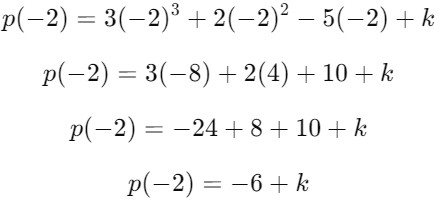Time: 1 hour
M.M. 30
Attempt all questions.
Question numbers 1 to 5 carry 1 mark each.
Question numbers 6 to 8 carry 2 marks each.
Question numbers 9 to 11 carry 3 marks each.
Question number 12 & 13 carry 5 marks each
Q1: Which of the following is a polynomial in one variable? (1 Mark)
(i)
(ii)
(iii)
(iv) 2/x + x
Ans: (ii)
A polynomial in one variable should not have any variable terms in the denominator or fractional exponents. It must have powers of a single variable with non-negative integers as exponents.
Option (i) is not a polynomial because includes a negative exponent.
Option (ii) is a polynomial in one variable , and it satisfies all conditions of a polynomial.
Option (iii) has two variables ( and ), so it’s not a polynomial in one variable.
Option (iv) contains , which has a negative exponent.
Q2: What is the degree of the polynomial ? (1 Mark)
(i) 1
(ii) 2
(iii) 3
(iv) 4
Ans: (iii)
The degree of a polynomial is the highest power (exponent) of the variable in the polynomial. In the polynomial 5x3+4x2−x+2, the highest power of is 3.
Thus, the degree of this polynomial is 3.
Q3: Which of the following is a zero of the polynomial ? (1 Mark)
(i) 1
(ii) 0
(iii) 3
(iv) -3
Ans: (iii)
A zero of a polynomial is a value of x that makes the polynomial equal to zero. To find the zero of , we set the polynomial equal to 0:
x=3
Thus, 3 is the zero of the polynomial.
Q4: What is the degree of the constant polynomial 7? (1 Mark)
(i) 0
(ii) 1
(iii) Not defined
(iv) 7
Ans: (i)
A constant polynomial is a polynomial with no variable terms (it is just a number). The degree of a constant polynomial is always 0 because there are no variables with exponents.
Thus, the degree of the constant polynomial 7 is 0.
Q5: The factor theorem states that x−a is a factor of the polynomial p(x) if: (1 Mark)
(i)p(a)=1
(ii) p(a)=a
(iii) p(a)=0
(iv)
Ans: (c)
According to the factor theorem, is a factor of a polynomial if and only if . This means that if you substitute into the polynomial and the result is zero, then is a factor of the polynomial.
Q6: Find the value of , if is a factor of . (2 Marks)
Ans: Since is a factor of , by the Factor Theorem, .
Now, substitute into the polynomial :

Since , we can set up the equation:
Solve for :
Thus, the value of is 6.
Q7: Factorize the quadratic expression
Ans: To factorize the quadratic expression , we need to split the middle term (7x) into two terms whose product is equal to , and whose sum is equal to 7.
The two numbers that satisfy these conditions are 8 and -1 (since and ).
So, we rewrite the expression as:
Now, group the terms:
Factor out the common terms:
Now, factor out :
Thus, the factorized form of is:
Q8: Evaluate without multiplying directly.
Ans:
To evaluate without direct multiplication, we can use the distributive property.
Rewrite the numbers:
Apply the distributive property :
Calculate each term:
so
Combine the results:
Q9: Use the Factor Theorem to determine whether is a factor of . (3 Marks)Ans:
To check if is a factor of using the Factor Theorem, we first evaluate .
Evaluate :
Since , is a candidate for being a factor.
Perform polynomial long division of by :
- Divide the leading term by to get .
- Multiply by :
- Subtract this from :
- Now, divide the leading term by to get .
- Multiply by :
- Subtract:
- Finally, divide by to get .
- Multiply by :
- Subtract:
Since the remainder is 15, which is not 0, we conclude that is not a factor of .
Q10: Expand .(3 Marks)
Ans:
Identify the terms:
Apply the expansion formula:
Calculate each term:
Combine the results:
Q11: If , show that (3 Marks)
Given the condition , we can use the identity for the sum of cubes:
Since , we can substitute this into the identity:
This simplifies to:
Thus, we can conclude that:
Ans:
Given,
Area of rectangle = 25x2 – 35x + 12
We know, area of rectangle = length × breadth
So, by factoring 25x2 – 35x + 12, the length and breadth can be obtained.
25x2 – 35x + 12 = 25x2 – 15x – 20x + 12
=> 25x2 – 35x + 12 = 5x(5x – 3) – 4(5x – 3)
=> 25x2 – 35x + 12 = (5x – 3)(5x – 4)
So, the length and breadth are (5x – 3)(5x – 4).
Now, perimeter = 2(length + breadth)
So, perimeter of the rectangle = 2[(5x – 3)+(5x – 4)]
= 2(5x – 3 + 5x – 4) = 2(10x – 7) = 20x – 14
So, the perimeter = 20x – 14
Q13: Factorize (5 Marks)
Ans:
To factor the expression , we can rearrange and group the terms.
Rearranging the expression:
Group terms:
Factor out common terms from each group:
From , factor out 4:
From , we can rearrange and factor:

Putting it together: =4(x2−xy+xz)+2(y2−2yz+z2)
Factoring further:
Notice can be recognized as:
And for := (y - z)^2
Finally, we can express the entire factorization as:




















